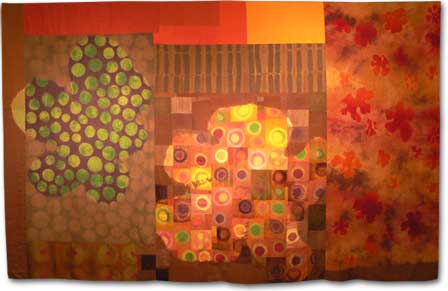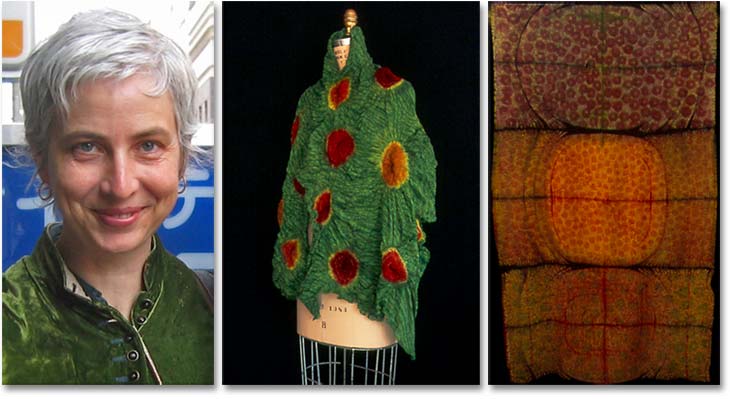JOAN MORRIS
Joan Morris began making shibori in 1983, the same year that marked her beginning to work as master-dyer for the theatre department at Dartmouth College, where she continues to work. She has dyed the textiles for over 60 productions there. Joan began teaching shibori in 1989. She teaches shibori internationally to adults, as well as to children in the schools of the northeastern United States. In 1997 she designed the textiles for a scene in Julie Taymor’s “The Lion King”. Since then she has fabricated the textiles for its international and road productions. She has been working on the creation of a merger of painting, printing, erasing, gilding and shaped resist dyeing for the past 12 years. Her shibori textiles have been exhibited nationally and internationally.
Joan Morris and examples of her work. Images below of Joan's workshop and student work.
 |
|
NATURAL DYE EXTRACTS & AN INDIGO POT:
All you need to make shibori textiles
• Dates: March 30-April 3, 2009
• Level: Beginning to Advanced
• Zig Zag Sewing Machine: No
• Tuition & Meal Plan: $770
• Materials Fee: $40
• Dye Facility Usage Fee: $25
> Accommodations and meal information
DESCRIPTION
The focus of this class will be on creating wonderful, subtle color using dyes from only the plant world to pattern fabric that has been shaped and bound before dyeing. By stitching, pleating or wrapping and then binding before dyeing, exquisite patterns emerge that are visual and textural memories of the shaping process. For this workshop we will use an indigo vat process for blues. Indigo has a rich and mysterious history in the world of textiles. It imparts a blue to cloth that has inspired people around the world for thousands of years. We will concentrate on preparing shibori using cottons and linens for our work in the indigo vat. Several different plant dye extracts (all inter-mixable), will also be used to dye silk and wool along with our cotton, linen and hemp. These include madder, a root used for red, peach and rust shades. From osage and fustic we’ll derive yellow and ochre hues, and cutch, a wood source, will give us rich browns. Experiments with cochineal will produce fantastic magentas, pinks and reds. As time permits, we’ll use cochineal extracts along with a dye bath of genuine dried cochineal bugs. Students will learn safe ways of handling dyes and mordants *. Using only alum as our mordant, we’ll shift color with iron sulfate and vinegar. The instructor’s extensive collection of shaped-resist dyed textiles from around the world will be used as a resource. Plant dye extracts are viewed as a sustainable way of plant-dyeing, and are convenient and safe to use. They produce a wide range of deep and subtle color, and work brilliantly with Shibori.
* Mordants are metallic salts which allow the dyes to attach to the fiber “permanently”.
SUPPLY LIST
Please bring all supplies to first day of class
• 3-5 yards (total) of white or off-white pre-washed 100% linen, hemp, ramie and/or rayon fabric. Some of each is good, for a total of 3-5 yards. Pre-wash, hang to dry, do not iron. Please note that cotton works the LEAST well of the cellulose fibers for natural dyeing with the extracts. Cotton does work beautifully with indigo though. Some cottons do well with natural dyes, but you will be better off with linen, hemp, ramie or rayon. Silk-rayon velvet works wonderfully with the plant dye extracts. The fabric you select should not be difficult to sew through by hand.
• 3-5 yards of white or off-white silk and wool; some of each is good for a total of 3-5 yards. Pre-wash, hang to dry, do not iron. The fabric you select should not be difficult to sew through by hand.
• 2 large spools of white or beige cotton-covered polyester thread (Dual Duty brand is best if you can get it) This thread needs to be fairly strong, but do not get nylon thread or buttonhole thread. Regular sewing thread size is good.
 |
|
Portrait of 2 Flowers, © 2008 Joan Morris, 72" x 108", shibori and mechanical resist |
• scissors
• notebook and pen
• seam ripper
• water soluble fabric marking pen or pencil available at sewing supply stores
• selection of needles for hand sewing
• 1 ball of cotton kite string or thin-medium weight cotton packing string, cotton-poly blend OK, NOT nylon
• clearview ruler (at fabric/quilting or art supply stores) OPTIONAL
• rubber gloves (such as for dish-washing; not "surgical" gloves)
• long rubber gloves for dyers are available at Pro-Chem (1.800.2 BUY DYE)
• safety goggles
• straight pins OPTIONAL
• smock
• permanent laundry marker (black), such as "Rub a Dub" brand
• plastic bowl or pail (1 gallon holding capacity or more)
OPTIONAL: We will be using this material for the indigo vat (cold), for arashi (pole-wrapped) shibori. Bring one or two lengths of non-perforated PVC plumbing pipes (or polypropylene, which is more durable in hot dyepots, but more expensive)…3” to 6” diameter is good, 3’ to 4’ length may be useful, “schedule 40” is most durable. This material is available at plumbing supply stores.
We will be using these plant extracts at a high temperature, so steam will be produced. The dyes are non-toxic, but they produce vapors when they are being prepared and used. A respirator should be worn when mordanting with aluminum acetate, the material we use for mordanting cellulose materials. I use a respirator with organic/acid gas cartridges. These are available through Hawkin Safety in Farmington, NH, phone (603) 627-6770 or online at www.northsafety.com. I recommend: North respirator #7700-30S with cartridges #75SC and dust filters and plastic caps #7506N95. If you have a respirator that you prefer, please bring that.
> Close this window to return to the main site or click on a link below | Questions? > Email
Nancy Crow | Home | Tours | Barn Workshops | New Book | Gallery | Bio | Email
© 2002-2009 Nancy Crow, llc | Site designed by Nathaniel Stitzlein | Art Grange Studios
Notice: All images & materials on this site are protected by copyright law and may not be reproduced in whole or in part without the express written permission of Nancy Crow or the artist.

> Click here to see an image gallery of the Crow Timber Frame Barn
